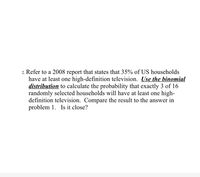
A First Course in Probability (10th Edition)
10th Edition
ISBN: 9780134753119
Author: Sheldon Ross
Publisher: PEARSON
expand_more
expand_more
format_list_bulleted
Question

Transcribed Image Text:2. Refer to a 2008 report that states that 35% of US households
have at least one high-definition television. Use the binomial
distribution to calculate the probability that exactly 3 of 16
randomly selected households will have at least one high-
definition television. Compare the result to the answer in
problem 1. Is it close?
Expert Solution
This question has been solved!
Explore an expertly crafted, step-by-step solution for a thorough understanding of key concepts.
This is a popular solution
Trending nowThis is a popular solution!
Step by stepSolved in 2 steps

Knowledge Booster
Similar questions
- 3. Two board members were chosen at random from 12 candidates of which 8 were independent candidates. a. Determine the probability distribution for the number of independent candidates selected. b. Find the mean and the variance of the distribution of the number of independent candidates chosen as board members.arrow_forwardPollsters are concerned about declining levels of cooperation among persons contacted in surveys. A pollster contacts 95 people in the 18-21 age bracket and finds that 81 of them respond and 14 refuse to respond. When 260 people in the 22-29 age bracket are contacted, 235 respond and 25 refuse to respond. Assume that 1 of the 355 people is randomly selected. Find the probability of getting someone in the 22-29 age bracket or someone who responds.Report the answer as a percent rounded to one decimal place accuracy. You need not enter the "%" symbol.P(22-29 or responds) =arrow_forwardA recent survey reported that 57% of 18- to 29-year-olds in a certain country own tablets. Using the binomial distribution, complete parts (a) through (e) below. a. What is the probability that in the next six 18- to 29-year-olds surveyed, four will own a tablet? b. What is the probability that in the next six 18- to 29-year-olds surveyed, all six will own a tablet? c. What is the probability that in the next six 18- to 29-year-olds surveyed, at least four will own a tablet? d. What are the mean and standard deviation of the number of 18- to 29-year-olds who will own a tablet in a survey of six? e. What assumption(s) do you need to make in (a) through (c)?arrow_forward
- 1. Approximately 90% of all people are right-handed. Consider a grouping of ten people. Assume that therequirements for a binomial distribution have been satisfied. a. What is the probability that 4 of them will be right handed?arrow_forwardApproximately 90% of all people are right handed. Consider a grouping of ten people. Assume the requirements for a binomial distribution have been satisfied. a. What is the probability that 4 of them will be right handed? b. What is the probability that at least 3 of them will be right handed?arrow_forward1. Refer to a 2008 report that states that 35% of US households have at least one high-definition television. Use the approximation to the binomial distribution to calculate the probability that exactly 3 of 16 randomly selected households will have at least one high-definition televisionarrow_forward
- According to a survey, the distribution of graduate science students in doctorate-granting institutions is shown to the right. Frequencies are in thousands. A graduate science student who Field is attending a doctorate-granting institution is selected at random. Complete parts a through c. Frequency - Physical sciences 34.7 Environmental sciences 11.1 Mathematical sciences 17.5 Computer sciences Agricultural sciences Biological sciences Psychology 43.6 11.8 64.5 45.1 Social sciences 88.5 a. Determine the probability that the field of the student obtained is psychology. (Round to three decimal places as needed.)arrow_forwardPollsters are concerned about declining levels of cooperation among persons contacted in surveys. A pollster contacts 102 people in the 18-21 age bracket and finds that 87 of them respond and 15 refuse to respond. When 249 people in the 22-29 age bracket are contacted, 220 respond and 29 refuse to respond. Assume that 1 of the 351 people is randomly selected. Find the probability of getting someone in the 22-29 age bracket or someone who responds. Report the answer as a percent rounded to one decimal place accuracy. You need not enter the "%" symbol. P(22-29 or responds) = %3D (Hint: It might be helpful to organize the data into a table first.) Submit Question 17,194 7. NOV tv 17 MacBook Airarrow_forward
arrow_back_ios
arrow_forward_ios
Recommended textbooks for you
 A First Course in Probability (10th Edition)ProbabilityISBN:9780134753119Author:Sheldon RossPublisher:PEARSON
A First Course in Probability (10th Edition)ProbabilityISBN:9780134753119Author:Sheldon RossPublisher:PEARSON

A First Course in Probability (10th Edition)
Probability
ISBN:9780134753119
Author:Sheldon Ross
Publisher:PEARSON
